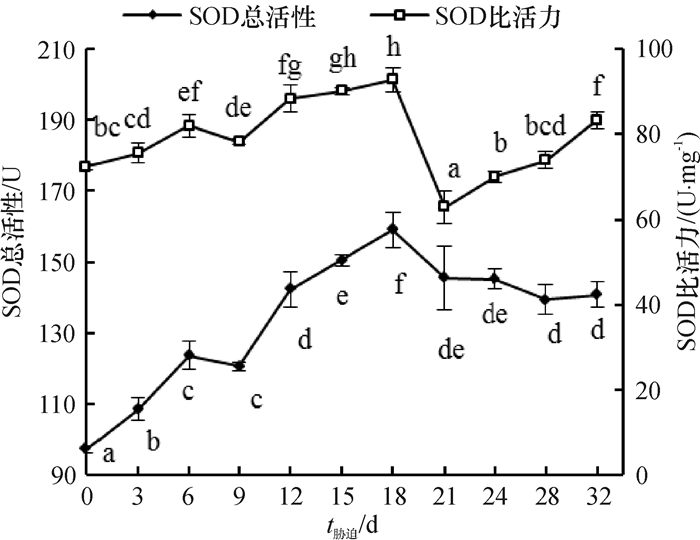Physiological responses of the limestone endemic plant Triadica rotundifolia seedlings to drought stress
-
摘要:目的
探讨圆叶乌桕Triadica rotundifolia幼苗对干旱胁迫的生理响应机制,为深入研究圆叶乌桕的抗旱性能提供基础依据,并为石漠化地区植被恢复及造林树种选择提供理论支持。
方法以2年生圆叶乌桕幼苗为试材,通过盆栽试验连续监测其在干旱胁迫下叶片各项生理指标的动态变化。
结果随着干旱胁迫的加剧,圆叶乌桕幼苗叶片相对电导率和游离脯氨酸含量显著上升,干旱末期分别达到峰值37.42%和197.18 μg·g-1;超氧化物歧化酶(SOD)总活性、丙二醛含量和可溶性蛋白含量均呈现先升后降的趋势,分别在干旱第18、21和21天达到峰值159.19 U、31.89 nmol·g-1和2.31 mg·g-1。
结论在不同干旱胁迫时期圆叶乌桕的生理响应机制不同,在轻度与中度干旱时期,体内抗氧化防御系统的积极防御与渗透调节能力的提高协同作用,以增强抗旱能力,在重度干旱时期,主要以渗透调节为主。总体而言,圆叶乌桕幼苗具有一定的耐旱潜能,是石漠化地区生态恢复的理想树种。
Abstract:ObjectiveTo study physiological response mechanisms of Triadica rotundifolia when subjected to drought stress, thus providing a fundamental evidence for further exploring its drought resistance and a theoretical support for afforestation tree species selection and vegetation restoration in limestone areas.
MethodPot experiment using 2-year-old T. rotundifolia seedlings was set up for observing the dynamic changes of the leaf physiological indexes of T. rotundifolia seedlings under drought stress.
ResultWith the development of drought stress, electrolyte leakage rate and proline content increased significantly, and peaked at the end of stress (32 days), with the values of 37.42% and 197.18 μg·g-1 respectively. SOD activity, MDA and soluble protein contents first increased and then decreased, and peaked at the 18th, 21th and 21th days with the values of 159.19 U, 31.89 nmol·g-1 and 2.31 mg·g-1 respectively.
ConclusionThe physiological response mechanisms of T. rotundifolia are different at different drought stress periods. Specifically in the light and moderate stress periods, drought resistance is enhanced by increasing the activities of protective enzymes combined with osmotic adjustment, but mainly by osmotic adjustment under severe stress. In general, T. rotundifolia has certain ability of drought tolerance, thus it is one of the suitable species for ecological restoration in limestone areas.
-
石漠化是喀斯特地区土地退化的极端形式,石质荒漠化地区土层浅薄、渗漏严重、保水性差,经常出现临时性干旱现象,因此地质性干旱是石漠化地区植被恢复与重建的首要限制因素[1-5]。大量研究表明,植物幼苗期的生理活动与干旱胁迫有密切关系[6-8]:随着干旱胁迫的加剧,质膜相对透性上升, 渗透调节物质可溶性糖、可溶性蛋白、游离脯氨酸含量等均有所增加,保护酶超氧化物歧化酶(SOD)活性表现先增加后减少,脂质过氧化物丙二醛(MDA)含量呈现逐渐上升趋势。
圆叶乌桕Triadica rotundifolia为大戟科乌桕属乔木树种,自然分布在中国南部与西南部喀斯特地区,是石灰岩地区的特有植物[9-10]。圆叶乌桕喜生于阳光充足的石灰岩山地,叶片Ca含量和吸收Ca能力较高,是嗜钙型植物也是钙质土的指示植物[11-12]。圆叶乌桕的叶解剖研究表明, 叶表皮具有较厚的角质层与蜡质层,表皮细胞小且排列紧密,气孔小且无规则形态,栅栏组织和海绵组织发达,栅栏组织细胞内叶绿体发达等适应石灰岩旱生环境的结构特征[13-15]。另外,圆叶乌桕枝叶凋落物的养分含量高,降解速率快,是喀斯特地区退化土地植被重建与土壤养分恢复较好的树种[16-17]。本研究选用圆叶乌桕为材料,通过盆栽试验研究干旱胁迫对圆叶乌桕幼苗生理生化指标的影响,探讨圆叶乌桕对干旱胁迫的生理响应机制,对认识石灰岩特有植物圆叶乌桕的抗旱性能有重要意义,为石漠化地区选择抗旱及耐旱性能好的植物材料提供理论支持与科学依据。
1. 材料与方法
1.1 试验材料
试验地设在华南农业大学林学院六楼南面的教学苗圃内,试验材料为石漠化地区树种圆叶乌桕2年生播种苗。于2014年3月采用25 cm×23 cm规格的花盆进行移植,每盆1株,移植40株,培养基质为V(河沙):V(黄心土):V(泥炭土)=5:3:2,基质土壤密度为(1.27±0.12)g·cm-3,田间持水量为(28.38±4.66)%。经过4个月的缓苗生长,苗木均长势良好,幼苗生长基本情况为苗高(23.04±4.19)cm、地径(14.11±1.71)mm。
1.2 试验设计
于2014年7月23日对所有供试苗木浇透水后,选取长势良好、生长情况相近的圆叶乌桕苗木30株,将花盆用塑料袋完全套住(从苗木根茎处覆盖整个表面,并密封花盆底部),以防止土壤的水分蒸发,并于当天第1次采样作为供试苗木正常水分条件对照,此后停止浇水进行自然干旱胁迫,在干旱第3、6、9、12、15、18、21、24、28、32天采样,进行各项生理指标测定。试验当天早上08:00,任意选取4株未挂牌幼苗上叶位相同(第3~5轮)的新鲜功能叶片共计8片,蒸馏水冲洗2~3次,吸水纸吸干叶表面水分后进行各项生理指标测定,每个指标设3个重复。随着干旱胁迫的进行,选用挂牌且未被破坏取样的6株圆叶乌桕幼苗定期检测土壤含水量。一般认为土壤质量含水量占田间持水量80%以上为正常水分条件(CK),50%~70%为轻度干旱(LD),30%~50%为中度干旱(MD),低于30%为重度干旱(SD)[18]。根据本试验测定的土壤含水量,最终确定封盆后的0~3 d为正常水分时期,此时土壤质量含水量占田间持水量的80%~100%,当土壤含水量下降至田间持水量的51%~70%(封盆后6~9 d)、32%~45%(封盆后12~18 d)、15%~26%(封盆后21~32 d)时,分别视为轻度干旱、中度干旱和重度干旱时期。
1.3 测定指标与方法
采用FOM/mts便携式土壤湿度计快速测定土壤体积含水量。土壤质量含水量(%)=体积含水量(%)/土壤容重(g·cm-3)。采用简易浸泡法测定叶片相对电导率[19];用硫代巴比妥酸(TBA)比色法测定丙二醛(MDA)含量[20];采用氯化硝基四氮唑蓝(NBT)光化还原法测定SOD活性[21];用考马斯亮蓝法测定可溶性蛋白质含量[21];用酸性茚三酮法测定脯氨酸含量[20]。
1.4 数据处理与分析
采用Excel 2007作图,SPSS 19.0进行AVOVA方差分析和Duncan’s多重比较。
2. 结果与分析
2.1 干旱胁迫对圆叶乌桕幼苗叶片相对电导率的影响
由图 1A可以看出,圆叶乌桕的叶片相对电导率随着干旱胁迫程度的加剧呈阶梯形升高的趋势。在正常水分时期(0~3 d)及轻度干旱时期(6~9 d),叶片相对电导率略微上升,但不显著且保持稳定,分别维持在8.5%和10.6%,在中度干旱时期(12~18 d)叶片相对电导率显著增大后维持在稳定水平(P<0.05),是正常水分条件的2.5倍,在重度干旱末期(28~32 d)叶片相对电导率再次显著提高(P<0.05),与正常水分条件相比增加了3.3倍。
2.2 干旱胁迫对圆叶乌桕幼苗叶片MDA含量的影响
从图 1B可以看出,随着干旱胁迫的进行,叶片MDA含量呈现先上升后下降的趋势。圆叶乌桕叶片MDA质量摩尔浓度在第0天为1.84 nmol·g-1,在轻度干旱时期(6~9 d)略微上升,在中度干旱和重度干旱时期(12~21 d)急剧上升,在第21天达到峰值51.36 nmol·g-1后显著下降并维持在较高水平(31.88~32.84 nmol·g-1)。
2.3 干旱胁迫对圆叶乌桕叶片渗透调节物质含量的影响
如图 1C所示,圆叶乌桕叶片脯氨酸含量随着干旱胁迫程度的加剧呈持续上升的趋势。其中,在干旱第0天脯氨酸质量分数为14.72 μg·g-1,在轻度干旱与中度干旱时期(6~20 d)上升缓慢(P<0.05),在重度干旱时期(21~32 d)急剧上升(P<0.05),第32天比第0天的叶片脯氨酸含量增加了12.4倍。由此说明,随着干旱胁迫的发展,尤其在干旱胁迫的后期,圆叶乌桕幼苗叶片脯氨酸积累现象越来越明显。
图 1D显示了干旱胁迫下圆叶乌桕叶片可溶性蛋白质的变化情况。其中第0天可溶性蛋白质质量分数为1.34 mg·g-1,在干旱处理后的前21 d内,可溶性蛋白质随着胁迫程度的加深,其含量逐渐升高,在第21天时,可溶性蛋白质质量分数达到峰值2.31 mg·g-1,比第0天显著上升了172.18%(P<0.05),此后可溶性蛋白质含量在重度干旱时期呈显著下降趋势。
2.4 干旱胁迫对SOD活性的影响
随着干旱胁迫的发生,叶片SOD比活力呈现先上升后下降再上升的变化(图 2),干旱第0天为72.35 U·mg-1,干旱第18天时达到峰值,为92.77 U·mg-1,干旱第21天达到最低值后显著上升;叶片SOD活性在第0天为97.22 U,随着干旱时间的持续而逐步增加(图 2),在第18天达到峰值159.19 U,比第0天活性增加63.7%,随后,SOD活性显著下降(P<0.05),并维持在较高的水平。
3. 讨论与结论
3.1 干旱胁迫下圆叶乌桕幼苗叶片相对电导率的变化特征
植物在逆境条件下,细胞质膜透性变化敏感,通过测定叶片电解质出率,在一定程度上可以了解植物组织受损伤的程度及膜的稳定性[22]。许多研究证实[23-24]:植物叶片相对电导率随着干旱胁迫程度的增加而逐渐上升,抗旱性较强的植物叶片相对电导率变化幅度较小。本试验结果表明,干旱胁迫初期对圆叶乌桕叶片相对电导率影响不大,随着干旱胁迫的进一步发展,部分电解质外渗,相对电导率升高,但此时渗透调节物质脯氨酸大量积累和SOD活性明显提高,有效维持了细胞膜的正常功能,有效抑制了膜质过氧化作用,使干旱中期叶片相对电导率仍能维持稳定,表明圆叶乌桕在一定程度的干旱胁迫下具有忍耐干旱的能力。这与赵家梅等[25]对道真润楠Machilus dauzhenensis的研究结果一致。
3.2 干旱胁迫下圆叶乌桕幼苗叶片渗透调节物质含量的变化特征
渗透调节是植物应对干旱胁迫的一种适应性生理机制。可溶性蛋白质具有亲水性胶体的性质,是一种重要的渗透调节物质[26]。干旱胁迫下可溶性蛋白质可以增强细胞的保水能力,以维持其正常的代谢活动,从而增强植物体的抗旱能力[26]。有研究表明[27-28],当受到干旱胁迫时,有些植物的可溶性蛋白质呈现先上升后下降的单峰曲线,可能是因为在水分亏缺的条件下,水解酶活性提高,使蛋白质合成受阻,产生游离氨基酸或被特定基因表达形成多肽(如干旱逆境蛋白质)。本试验中,圆叶乌桕幼苗叶片可溶性蛋白质含量在轻度和中度干旱胁迫下持续增加,表现出一定的耐受能力,而其可溶性蛋白质含量在重度胁迫时达峰值后急剧下降,可能是由于水解酶活性提高或特定多肽的产生,导致可溶性蛋白质含量显著下降(P<0.05)。这与鸭茅Dactylis glomerata和欧美Ⅰ-107杨Populus×euramericana cv. Neva的研究结果[27-28]一致。
脯氨酸是植物对干旱胁迫反应敏感的有机调节物质。大量研究表明,随着干旱胁迫的加重,植物体内脯氨酸含量大量累积,降低了渗透势,在一定范围维持膨压稳定[28-29]。本研究表明,在整个干旱胁迫时期,圆叶乌桕幼苗叶片通过快速积累脯氨酸,起到保护该树种免受渗透胁迫伤害的作用,表现出较强的耐旱潜力。
3.3 干旱胁迫下圆叶乌桕幼苗MDA含量和SOD活性的变化特征
超氧化物歧化酶(SOD)是保护酶系统中的关键酶之一,具有快速清除超氧自由基和有效控制膜质过氧化的功能[30-32]。在干旱条件下,SOD活性的变化因树种及其受到胁迫方式、程度的不同而不同。前人研究表明,在干旱胁迫初期,植物SOD活性提高,从而抵御逆境,但随着胁迫程度加深,植物代谢发生紊乱,特别是在胁迫中后期,SOD活性显著降低[30-31, 33]。这与本试验研究结果一致,随着干旱程度的加重,圆叶乌桕叶片SOD活性显著提高,虽然在重度胁迫时期其酶活性出现下降,但仍高于对照,说明圆叶乌桕通过增强SOD酶活性,有效地清除代谢失调而产生的过剩自由基,提高了圆叶乌桕适应干旱胁迫的能力。
丙二醛(MDA)是膜质氧化降解的主要产物,其含量的变化直接反映了植物受逆境的程度。有研究表明,膜质过氧化产物与保护酶活性存在一定的相关性[32, 34]。本研究中圆叶乌桕叶片的MDA含量在中度和重度干旱胁迫下都显著提高,且重度干旱胁迫的MDA含量低于中度干旱胁迫, 说明圆叶乌桕可能由于前期适应干旱的锻炼,形成了一定的抗旱机制,这与红花玉兰Magnolia wufengensis[35]和荒漠植物红砂Reaumuria soongorica[30]的研究结果相似。
3.4 不同干旱时期圆叶乌桕的生理响应机制不同
综上所述,圆叶乌桕的生理代谢受到土壤水分亏缺的显著影响,其对干旱的适应能力也较强。圆叶乌桕在面对不同程度干旱胁迫时响应机制不同,当圆叶乌桕处于轻度干旱和中度干旱时,主要体现为叶片相对电导率的增加、膜质过氧化程度加剧、活性氧自由基增加,但由于植物体内渗透调节物质(脯氨酸、可溶性蛋白质)含量的增加和SOD酶积极抵御活性氧伤害的协同作用,有效缓解了水分亏缺对圆叶乌桕幼苗造成的伤害;而当圆叶乌桕处于重度干旱时,胁迫程度超过了保护酶SOD积极防御的范畴,其活性下降,此时主要的生理响应机制是通过提高渗透物质的含量,增强圆叶乌桕的叶片保水性从而提高抵抗干旱的能力。
本研究各生理指标的测定结果初步证明,圆叶乌桕幼苗对干旱胁迫响应积极,表现出一定的耐旱潜力,从这个角度来看,圆叶乌桕对水分亏缺具有较强的生态适应能力,可在石漠化地区进行生态恢复时作为重点考虑树种。
-
-
[1] JIANG Z, LIAN Y, QIN X. Rocky desertification in Southwest China: Impacts, causes, and restoration[J]. Earth-Sci Rev, 2014, 132: 1-12. doi: 10.1016/j.earscirev.2014.01.005
[2] 吴华丽, 代小燕.喀斯特地区石漠化生境特征与植被恢复的植物选择探讨[J].水土保持应用技术, 2014, 34(4): 39-42. doi: 10.3969/j.issn.1673-5366.2014.04.17 [3] 郭柯, 刘长成, 董鸣.我国西南喀斯特植物生态适应性与石漠化治理[J].植物生态学报, 2011, 35(10): 991-999. http://d.old.wanfangdata.com.cn/Periodical/zwstxb201110001 [4] CAI H, YANG X, WANG K, et al. Is forest restoration in the Southwest China Karst promoted mainly by climate change or human-induced factors?[J]. Remote Sens, 2014, 6(10): 9895-9910. doi: 10.3390/rs6109895
[5] 盛茂银, 熊康宁, 崔高仰, 等.贵州喀斯特石漠化地区植物多样性与土壤理化性质研究[J].生态学报, 2015, 35(2): 434-448. http://d.old.wanfangdata.com.cn/Periodical/stxb201502025 [6] 牛素贞, 樊卫国.喀斯特地区古茶树幼苗对干旱胁迫的生理响应及其抗旱性综合评价[J].园艺学报, 2013, 40(8): 1541-1552. http://d.old.wanfangdata.com.cn/Periodical/yyxb201308014 [7] 张中峰, 尤业明, 黄玉清, 等.模拟喀斯特生境条件下干旱胁迫对青冈栎苗木的影响[J].生态学报, 2012, 32(20): 6318-6325. http://d.old.wanfangdata.com.cn/Periodical/stxb201220005 [8] 刘长成, 刘玉国, 郭柯.四种不同生活型植物幼苗对喀斯特生境干旱的生理生态适应性[J].植物生态学报, 2011, 35(10): 1070-1082. http://d.old.wanfangdata.com.cn/Periodical/zwstxb201110009 [9] 徐瑞晶, 黄川腾, 周雪刚, 等.清新和阳山县圆叶乌桕群落物种多样性和优势种群动态探讨[J].热带亚热带植物学报, 2013, 21(6): 496-504. doi: 10.3969/j.issn.1005-3395.2013.06.002 [10] 秦新生. 2种石灰岩特有植物的特性及园林应用[J].广东园林, 2011, 33(1): 52-54. doi: 10.3969/j.issn.1671-2641.2011.01.013 [11] 罗绪强, 张桂玲, 杜雪莲, 等.茂兰喀斯特森林常见钙生植物叶片元素含量及其化学计量学特征[J].生态环境学报, 2014, 23(7): 1121-1129. doi: 10.3969/j.issn.1674-5906.2014.07.005 [12] 刘锡辉, 秦新生, 梁同军, 等.石灰岩特有植物圆叶乌桕土壤与叶片化学元素含量特征[J].西南农业学报, 2013, 26(3): 1195-1200. doi: 10.3969/j.issn.1001-4829.2013.03.069 [13] 何敏宜, 袁锡强, 秦新生.石灰岩特有植物圆叶乌桕叶表皮形态特征及其生态适应性研究[J].西北植物学报, 2012, 32(4): 709-715. doi: 10.3969/j.issn.1000-4025.2012.04.012 [14] 李荣峰, 周琼, 黎桦, 等.桂西南石灰岩地区圆叶乌桕的生态解剖结构研究[J].百色学院学报, 2009, 22(3): 78-80. doi: 10.3969/j.issn.1673-8233.2009.03.015 [15] 潘昕, 邱权, 李吉跃, 等.基于叶片解剖结构对青藏高原25种灌木的抗旱性评价[J].华南农业大学学报, 2015, 36(2):61-68. http://xuebao.scau.edu.cn/zr/hnny_zr/ch/reader/view_abstract.aspx?flag=1&file_no=201502013&journal_id=hnny_zr [16] 曾昭霞, 刘孝利, 王克林, 等.桂西北喀斯特区原生林与次生林凋落物储量及持水特性[J].生态学杂志, 2011, 30(7): 1429-1434. http://d.old.wanfangdata.com.cn/Periodical/stxzz201107020 [17] 曾昭霞, 王克林, 曾馥平, 等.桂西北喀斯特区原生林与次生林凋落叶降解和养分释放[J].生态学报, 2012, 32(9): 2720-2728. http://d.old.wanfangdata.com.cn/Periodical/stxb201209010 [18] 潘昕, 邱权, 李吉跃, 等.干旱胁迫对两种速生树种叶绿素含量的影响[J].桉树科技, 2013, 30(3): 17-22. doi: 10.3969/j.issn.1674-3172.2013.03.003 [19] 高俊凤.植物生理学实验指导[M].北京:高等教育出版社, 2006:208-209. [20] 邹琦.植物生理学实验指导[M].北京:中国农业出版社, 2003:173-174. [21] 李合生.植物生理生化实验原理和技术[M].北京:高等教育出版社, 2000:167-169. [22] 陈少瑜, 郎南军, 李吉跃, 等.干旱胁迫下3树种苗木叶片相对含水量、质膜相对透性和脯氨酸含量的变化[J].西部林业科学, 2004, 33(3): 30-33. doi: 10.3969/j.issn.1672-8246.2004.03.005 [23] 谷文众, 刘杨, 谷振军.干旱胁迫对金盏菊膜脂过氧化及保护酶活性的影响[J].经济林研究, 2009, 27(3): 79-81. doi: 10.3969/j.issn.1003-8981.2009.03.017 [24] 苏寒之, 金建邦, 祝遵凌.干旱胁迫对北美红栎幼苗生理特性的影响[J].东北林业大学学报, 2014, 42(8):34-39. doi: 10.3969/j.issn.1000-5382.2014.08.008 [25] 赵家梅, 谢双喜.干旱胁迫和复水对道真润楠幼树生理特性的影响[J].贵州农业科学, 2013, 41(3): 116-118. doi: 10.3969/j.issn.1001-3601.2013.03.032 [26] 李永洁, 李进, 徐萍, 等.黑果枸杞幼苗对干旱胁迫的生理响应[J].干旱区研究, 2014, 31(4): 756-762. http://d.old.wanfangdata.com.cn/Periodical/ghqyj201404026 [27] 季杨, 张新全, 彭燕, 等.干旱胁迫对鸭茅根、叶保护酶活性、渗透物质含量及膜质过氧化作用的影响[J].草业学报, 2014, 23(3): 144-151. http://d.old.wanfangdata.com.cn/Periodical/caoyexb201403016 [28] 井大炜, 邢尚军, 马海林, 等.水分胁迫对欧美Ⅰ-107杨树苗生理生化特性的影响[J].干旱区资源与环境, 2015, 29(1): 53-58. http://d.old.wanfangdata.com.cn/Periodical/ghqzyyhj201501010 [29] 邵怡若, 许建新, 薛立, 等. 5种绿化树种幼苗对干旱胁迫和复水的生理响应[J].生态科学, 2013, 32(4): 420-428. [30] 白娟, 龚春梅, 王刚, 等.干旱胁迫下荒漠植物红砂叶片抗氧化特性[J].西北植物学报, 2010, 30(12): 2444-2450. http://d.old.wanfangdata.com.cn/Periodical/xbzwxb201012014 [31] PAN Y, WU L J, YU Z L. Effect of salt and drought stress on antioxidant enzymes activities and SOD isoenzymes of liquorice (Glycyrrhiza uralensis Fisch)[J]. Plant Growth Regul, 2006, 49(2/3): 157-165. http://www.wanfangdata.com.cn/details/detail.do?_type=perio&id=JJ022005390
[32] FAROOQ M, WAHID A, KOBAYASHI N, et al. Plant drought stress: Effects, mechanisms and management[J]. Agron Sustain Dev, 2009, 29(1): 185-212. doi: 10.1051/agro:2008021
[33] 刘锦春, 钟章成, 何跃军.干旱胁迫及复水对喀斯特地区柏木幼苗活性氧清除系统的影响[J].应用生态学报, 2011, 22(11): 2836-2840. http://d.old.wanfangdata.com.cn/Periodical/yystxb201111008 [34] 黄兴荣.喀斯特生境模拟对一年生茶条木植株生长、生理的影响[J].现代园艺, 2014, 36(12): 11-12. doi: 10.3969/j.issn.1006-4958.2014.12.005 [35] 桑子阳, 马履一, 陈发菊.干旱胁迫对红花玉兰幼苗生长和生理特性的影响[J].西北植物学报, 2011, 31(1): 109-115. http://d.old.wanfangdata.com.cn/Periodical/xbzwxb201101018




 下载:
下载:

